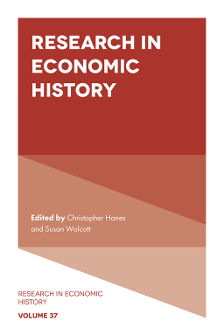Research in Economic History: Volume 37

Table of contents
(6 chapters)Abstract
This study examines a sharp decline of school attendance among white children in the Southern US after the Civil War. According to Census data, the school-attendance rate among whites in the Confederate states declined by almost half from 1860 to 1870, whereas the rate in Northern states was approximately stable. This shock left the South approximately three decades behind its antebellum trend. We account for little of this drop with household variables plausibly affected by the War. However, a select few county-level variables (notably the drop in wealth) explains around half of the decline, which suggests a systemic explanation. We adopt a model-based approach to decomposing the decline in schooling into demand versus supply factors. On the supply side, the region saw a decline in wealth and public resources, but we observe a stable relationship between time in school and literacy or adult occupation, which is not consistent with a contracting constraint on school quantity or quality. Nevertheless, further research is required to determine how much the contraction in school access affected attendance. On the demand-side, we present suggestive evidence of a decline in the return to school (measured by the relative wage of engineers to laborers). Relatedly, we see a “brain drain”: in longitudinally linked census samples, educated Southerners were more likely to migrate out of the South after the War.
Abstract
The experimental parliamentary subsidy on knights' fees and freehold incomes from lands and rents of 1431 was the only English direct lay tax of the Middle Ages which broke down. As such, this subsidy has a clear historiographical significance, yet previous scholars have tended to overlook it on the grounds that parliament's annulment act of 1432 mandated the destruction of all fiscal administrative evidence. Many county assessments from 1431–1432 do, however, survive and are examined for the first time in this article as part of a detailed assessment of the fiscal and administrative context of the knights' fees and incomes tax. This impost constituted a royal response to excess expenditures associated with Henry VI's “Coronation Expedition” of 1429–1431, the scale of which marked a decisive break from the fiscal-military strategy of the 1420s. Widespread confusion regarding whether taxpayers ought to pay the feudal or the non-feudal component of the 1431 subsidy characterized its botched administration. Industrial scale under-assessment, moreover, emerged as a serious problem. Officials' attempts to provide a measure of fiscal compensation by unlawfully double-assessing many taxpayers served to increase administrative confusion and resulted in parliament's annulment act of 1432. This had serious consequences for the crown's finances, since the regime was saddled with budgetary and debt problems which would ultimately undermine the solvency of the Lancastrian state.
Abstract
The US fertility transition in the nineteenth century is unusual. Not only did it start from a very high fertility level and very early in the nation’s development, but it also took place long before the nation’s mortality transition, industrialization, and urbanization. This paper assembles new county-level, household-level, and individual-level data, including new complete-count IPUMS microdata databases of the 1830–1880 censuses, to evaluate different theories for the nineteenth-century American fertility transition. We construct cross-sectional models of net fertility for currently-married white couples in census years 1830–1880 and test the results with a subset of couples linked between the 1850–1860, 1860–1870, and 1870–1880 censuses. We find evidence of marital fertility control consistent with hypotheses as early as 1830. The results indicate support for several different but complementary theories of the early US fertility decline, including the land availability, conventional structuralist, ideational, child demand/quality-quantity tradeoff, and life cycle savings theories.
Abstract
This chapter deals with the development of banking in the Crown of Aragon from the end of the thirteenth century through the establishment of money changers, which followed similar patterns as in other Western European territories. It starts with a review of existing literature and follows with an explanation on the different banking services provided by money changers and the specific legal framework that supported such activities. It then examines the geographical distribution of private banks in cities and towns within the domains of the kings of Aragon, as well as their evolution throughout the fourteenth century. After that, it offers an analysis of the most common professional profiles among these bankers and financers. Finally, drawing on a heterogeneous pool of unpublished data, it seeks to shed light on the diversity of investors and clients of these establishments, a crucial proof of their role in integrated financial markets.
Abstract
One of the most important, least-known documents of the American Revolution was a 25-page pamphlet published in Amsterdam early in 1787: An Explanatory Message Concerning the Funds by Pieter Stadnitski. 1 Within a year of its publication Peter Stadnitski's Message quite literally revolutionized American sovereign finance. My paper will summarize in detail the report's content and analyze its arguments in light of Dutch archival materials including deeds, newspaper reports, and letters, as well as congressional records from American sources. It will describe what Dutch investors knew (and did not know) of the state of American public finance and American political landscape, and the Dutch financial community's view of the American future. Its essential argument is that thanks initially to Stadnitski's persuasive case and ultimately to the success of the trusts he pioneered, Dutch investment specialists came to see the American republic as a safe haven at a time that Dutch Republic's own future seemed increasingly perilous. If their dream of achieving a new Golden Age through trade and investment with the new nation ultimately proved illusory, the effects of Dutch capital in creating financial stability for the United States government and igniting the first peacetime economic expansion in American history were revolutionary indeed.

- DOI
- 10.1108/S0363-3268202137
- Publication date
- 2021-09-30
- Book series
- Research in Economic History
- Editors
- Series copyright holder
- Emerald Publishing Limited
- ISBN
- 978-1-80071-880-7
- eISBN
- 978-1-80071-879-1
- Book series ISSN
- 0363-3268